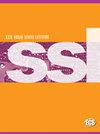Light-Induced Electrochemical Deposition of Ni for Si Solar Cell Processing
引用次数: 5
Abstract
This work outlines the general electrochemical features of the Ni light-induced deposition process. Typical observations for the deposition on textured solar cells are discussed and compared to planar n-Si (100) electrodes. The electrochemical measurements clearly show that after nucleation, Ni-on-Ni deposition is favored over Ni-on-Si, resulting in hemispherical growth. This observation is attributed to a kinetic effect and may be a disadvantage for the growth of ultra-thin contacting layers. In addition, the simultaneous metallization of fingers and busbars shows a significant non-uniformity due to an inevitable variation in current distribution which leads to an enhanced deposition rate for the narrowest features.光致电化学沉积镍用于硅太阳能电池的加工
本文概述了镍光致沉积工艺的一般电化学特征。讨论了在织构太阳能电池上沉积的典型观察结果,并与平面n-Si(100)电极进行了比较。电化学测量清楚地表明,在成核后,Ni-on-Ni比Ni-on-Si更有利于沉积,导致半球形生长。这种观察结果归因于动力学效应,可能是超薄接触层生长的不利因素。此外,由于电流分布的不可避免的变化,手指和母线的同时金属化表现出明显的不均匀性,这导致最窄特征的沉积速率提高。
本文章由计算机程序翻译,如有差异,请以英文原文为准。
求助全文
约1分钟内获得全文
求助全文

 求助内容:
求助内容: 应助结果提醒方式:
应助结果提醒方式:


